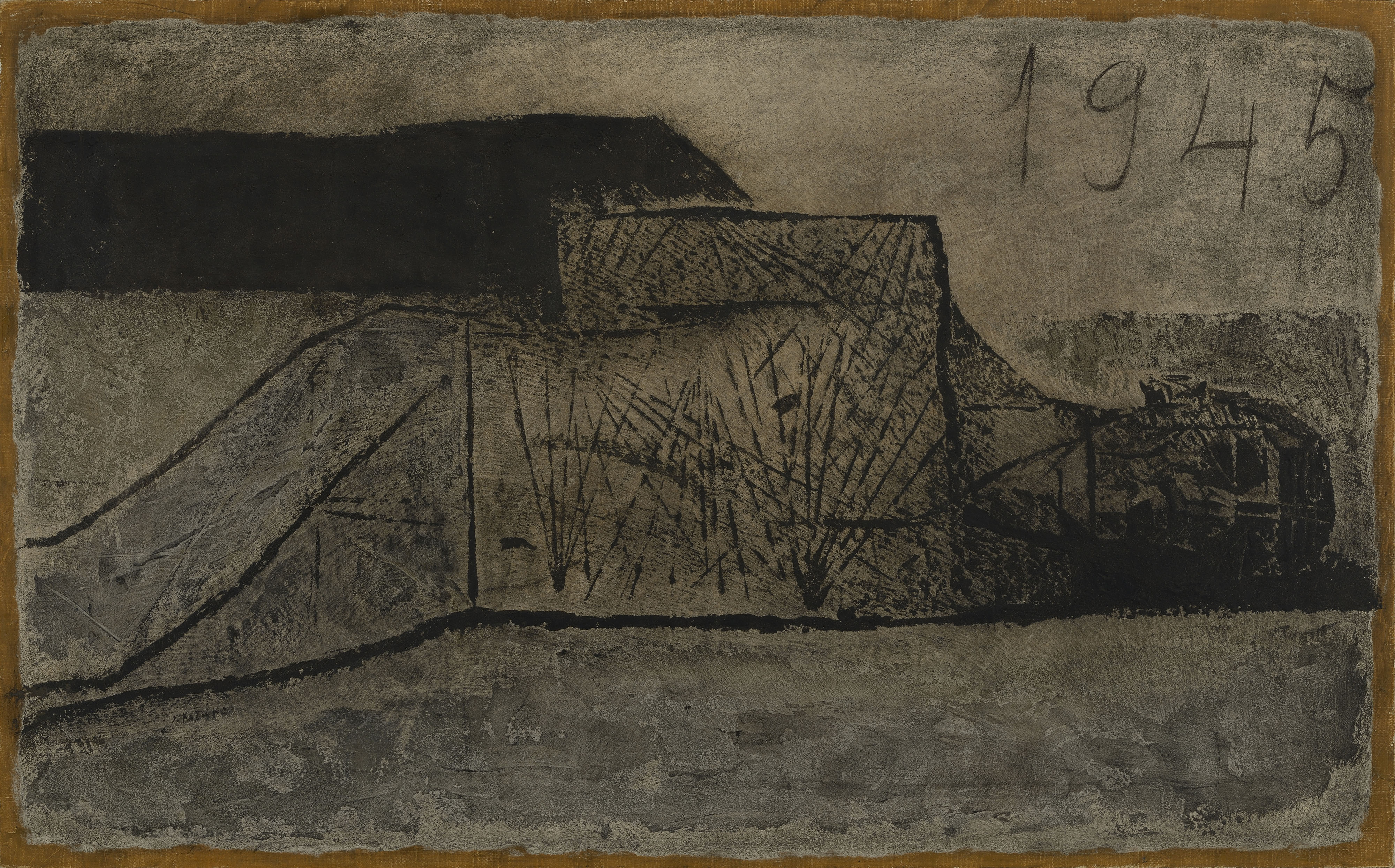
1945
1959(昭和34年)
油彩/カンヴァス
〈画家のことば〉
戦争が終ると、我々はソ連兵の傍若無人のふるまいと、現地人たちの憎悪の眼にさらされることになった。我々の貨車が通る鉄道沿線に、ならんだ彼等からツバを吐きかけられ、罵倒されたこともあった。
列車が奉天を出て、北上をはじめてまもなく、線路のわきに放り出された屍体を見た。満人たちの私刑で殺された日本人に違いない。衣服をはぎとられ、生皮をはがれたのか、異様な褐色の肌に、人間の筋肉を示す赤い筋が全身に走って、教科書の解剖図の人体そのままの姿だった。
帰国後、写真で見た広島の原爆の、真黒こげの屍体と、満州で貨車から瞬間見た赤茶色の屍体。二つの屍体が、1945年を語り尽していると思う。
『シベリヤ画集』(新潮社、1971年)
香月泰男【かづき やすお】
生没年 1911~1974(明治44年~昭和49年)
山口県大津郡三隅村(現・長門市三隅)に生まれた香月泰男は、東京美術学校で油彩画を学び、美術教員の傍ら国画会を中心に作品を発表しました。1967年、太平洋戦争への従軍と戦後のシベリア抑留の経験を描いた「シベリア・シリーズ」により、第一回日本芸術大賞を受賞。その作品は今日も多くの人々を惹きつけています。
| 寸法 | 72.8×116.7cm |
|---|---|
| 形状 | 額装 |

1945
1959
Oil on canvas
〈Painter’s words〉
Once the war ended, we were left exposed to the brutal arrogance of the Soviet soldiers, not to mention the outright hatred of the local populace. They would line the railway tracks to spit on us and hurl insults as our train rolled through.
Not long after the train pulled out of Mukden on its long journey north I saw an abandoned corpse by the side of the tracks. There was no doubt that it were Japanese who had been lynched by the local Manchurians. His clothes had been ripped from him and his skin was strangely brown, as if the skin itself had been ripped from the flesh. All over the bodies could be seen the distinctive redness of exposed muscles, like anatomical diagrams from a textbook.
The black charred corpses of those killed by the Hiroshima bomb that I saw in photos back in Japan and the corpse of red and brown that I saw from the train in Manchuria… for me, these are the enduring images of 1945.
Siberian Series (Shinchosha, 1971)
Kazuki Yasuo 1911 – 1974
Born in Misumi-mura (now Misumi, Nagato City) in Otsu-gun, Yamaguchi Prefecture. Studied oil painting at Tokyo School of Fine Arts, then taught fine art while producing works that were primarily exhibited at Kokugakai (National Painting Association). Kazuki was sent to fight in the Pacific War (WWII), then interned in Siberia after the war. This experience resulted in the Siberia Series, which won the inaugural Japan Art Grand Prize in 1967. This series is considered an important body of work that still resonates widely today.
| Size | 72.8×116.71cm |
|---|

1945
1959
《畫家的話》
戰爭一結束,我們就暴露在蘇聯士兵旁若無人的行為和當地人憎恨的目光下。在我們的貨車經過的鐵路沿線,被排在那裏的人們吐口水、並遭到謾罵。
列車離開奉天北上不久,我就看到被扔在鐵軌旁的屍體。肯定是被滿州人私刑殺害的日本人。不知道是被剝去了衣服,還是皮膚脫落了,異樣的褐色皮膚上,人的紅色肌肉條遍布全身,和教科書解剖圖上的人體一模一樣。
回國後,在照片上看到的廣島原子彈爆炸後的,漆黑燒焦的屍體,和在滿洲貨車上瞬間看到的紅褐色屍體。兩具屍體,已經訴說了1945年的一切。
《西伯利亞畫集》(新潮社 1971年)
香月泰男
生卒年 1911~1974(明治44年~昭和49年)
香月泰男出生於山口縣大津郡三隅村(現長門市三隅),在東京美術學校學習油畫,在擔任美術教員的同時,主要在國畫會發表作品。1967年, “西伯利亞係列 “獲得了第一屆日本藝術大獎,描繪了香月在太平洋戰爭中服役以及戰後被關押在西伯利亞的經曆。那些作品至今也受很多人歡迎。
| 尺寸 | 72.8×116.7cm |
|---|
